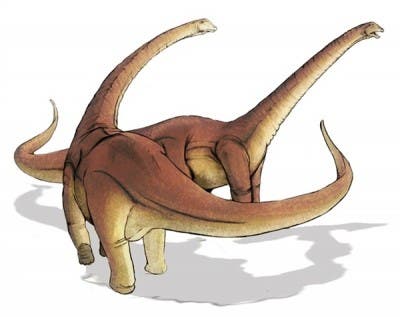
Paleontologists have been familiar with the Alamosaurus for decades since the first fossil sample was discovered in 1922, however previous assessments regarding its size have proved to be inaccurate. A team of researchers, now claims that he Alamosaurus was significantly more massive than originally thought after examining fossils they collected in New Mexico between 2003 and 2006. This would make the giant sauropod the biggest dinosaur so far discovered to have walked across North America.
New insights have the long-necked, long-tailed sauropod which roamed the continent 69 million years ago, at some imposing proportions – 70 tons in weight. If this is true, that’d make Alamosaurus twice as heavy as paleontologists thought it was just a few years ago, claims Denver Fowler, a researcher at Montana State University, and State Museum of Pennsylvania’s Robert Sullivan.
“Over the past 20 years, Argentinean and Brazilian paleontologists have been unearthing bigger and bigger dinosaurs, putting the rest of the world in the shade,” Fowler said in an MSU news release issued Tuesday. “However, our new finds not only show that Alamosaurus is newly recognized as the biggest dinosaur from North America, but also that it was right up there with the biggest South American species: The U.S. is back in the fight for the No.1 spot.”
The biggest impediment paleontologists face is fossil records. Large dinosaurs like the Alamosaurus or the Argetinosaurus, the largest dinosaur from South America, have been described so far only from a very limited amount of unearthed fossils. These various fragments do well in aiding scientists in painting a semi-accurate picture of long-gone creatures, however they only offer a tantalizing glimpse of what a complete Alamosaurus might look like, in this case.
“We’d love to find more complete material,” Fowler continued. “Fortunately, Alamosaurus bones are quite common in the Naashoibito of New Mexico, so we have a good chance of going back and finding more, but in order to dig up one of the world’s biggest dinosaurs you need one of the world’s biggest dinosaur digging teams and large digging equipment.”
What’s makes this study even more important, however, is that it shows how inaccurate some of our descriptions of past dinosaurs are.
“Increasingly, we’re finding that very large or small individuals often look very different, and are often described as different species,” Fowler said. “Our findings show that Alamosaurus was originally described based on immature material, and this is a problem as characteristics that define a species are typically only fully gained at adult size. This means that we might be misinterpreting the relationships of Alamosaurus and possibly other sauropod dinosaurs too.”
The researchers’ find was shared in a paper published Dec. 6 in Acta Palaeontologica Polonica.


